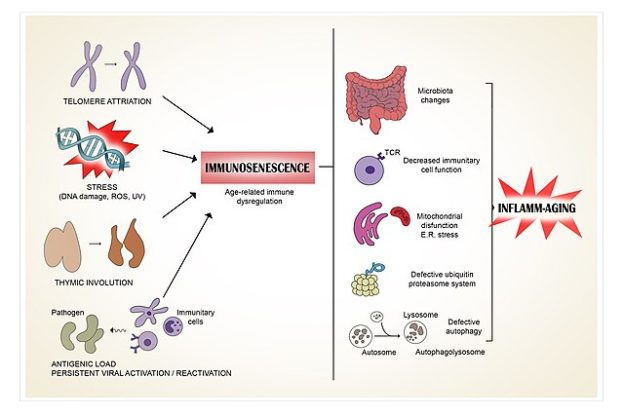Immunosenescence
Immunosenescence can be defined as immune function changes that contribute to the increased susceptibility to disease in older people. A related term is inflamm-aging, the persistence of chronic inflammation characteristic of immunosenescence.
The immune system consists of two branches, the innate system, and the acquired system. The innate system is the first line of defense of the body and consists of physical barriers such as skin and mucus membranes and various immune cells. The adaptive immune system develops from an antigen stimulus, such as an invading organism, and consists of T and B lymphocytes.
A significant change occurring in the innate immune system with immunosenescence is the appearance of chronic inflammation, caused by the increased production of pro-inflammatory cytokines.
Immunosenescence is characterized by a decline in acquired immunity, resulting in a reduced ability of older persons to respond to new infections and vaccines. Specifically, immunosenescence results in a decrease of naïve T and B cells. Naïve T or B cells have not yet been exposed to an antigen (an infectious agent). An increase in memory T and B cells (resulting from previous infections) are observed. These changes are thought to be partly due to the involution of the thymus (where T cells are produced).
A decrease in CD4 T helper cells occurs. CD4 T cells play essential roles in the functioning of the adaptive immune system.
Inflamm-imaging is characterized by an increase in pro-inflammatory cytokines. Cytokines are cell signaling molecules that aid cell to cell communication in immune responses and stimulate cells’ movement towards sites of inflammation, infection, and trauma. Interleukin-6 is a particularly detrimental cytokine.
The second article in this series will discuss the uses of nutrients for the prevention and treatment of immunosenescence.
The third article will discuss proposed non-nutritional treatments for immunosenescence. These proposed treatments must undergo further clinical trials to demonstrate their safety and effectiveness.
Attribution of image:
Creator: Raquelbusto
License: CCBY-Share Alike 4.0
http://creativecommons.org/licenses/by-sa/4.0/legalcode
References
- Aiello, A. et al. “Immunosenescence and Its Hallmarks: How to Oppose Aging Strategically? A Review of Potential Options for Therapeutic Intervention. Frontiers in Immunology”. Sept 2019. Vol. 10, Article 2247 https://www.frontiersin.org/articles/10.3389/fimmu.2019.02247/full
- Aw, Danielle, Alberto Silva and Donald Palmer. “Immunosenescence: emerging challenges for an ageing Population.” Immunology, 120,435-446. https://www.ncbi.nlm.nih.gov/pmc/articles/PMC2265901/
- Castle, Steven. “Clinical Relevance of Age-Related Immune function.” Clinical Infectious Diseases.” 2000;31: 578-85. https://academic.oup.com/cid/article/31/2/578/299255
- Ventura, Maria. “Immunosenescence in aging: between immune cells depletion and cytokines up‑” Clinical and Molecular Allergy. 2017, 15: 8 Bio Med Central https://www.ncbi.nlm.nih.gov/pmc/articles/PMC5731094/pdf/12948_2017_Article_77.pdf
